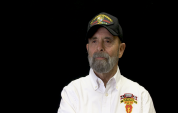8:32 | The casualties were mounting and Phil Mayrand needed to get these men to safety. He describes the attempt to get all of the incapacitated out of the field and back to the 12th Evacuation Hospital in Cu Chi after the ambush. Part 2 of 3 (Interview conducted at, and with the assistance of, The Veterans History Museum of the Carolinas.- https://theveteransmuseum.org/)
Keywords : Sappers Ambush Riverbank Satchel charge 12th Evacuation Hospital Cu Chi Internal bleeding Navy PBR Patrol Boat Brown Water Navy Evacuation Medevac(Medical Evacuation)

Phil Mayrand was drawn to the bravado of the military, and the appeal of being a Green Beret was too big of an opportunity to pass up. However, when his parents got wind of his plans, they pushed for him to go to college instead, but the draft would come for him eventually. He'd end up volunteering, and spent his first days training at Ft. Bragg. (Interview conducted at, and with the assistance of, The Veterans History Museum of the Carolinas.- https://theveteransmuseum.org/)
Phil Mayrand describes the furtherance of his infantry training leaving Ft. Bragg for Ft. Polk where he'd also meet some lifelong friends. The opportunity to get some additional leadership training presented itself, and anything he would agree to take would delay his inevitable trip to Vietnam, but an unfortunate injury would put this plan in jeopardy. (Interview conducted at, and with the assistance of, The Veterans History Museum of the Carolinas.- https://theveteransmuseum.org/)
Phil Mayrand had come out of Non-Commissioned Officer school, and was again met with a big choice. One was to go straight to the war and put his training to the test, the second was to take up Ranger School. At Ft. Benning he was put through his paces to push his limits both physically and mentally. (Interview conducted at, and with the assistance of, The Veterans History Museum of the Carolinas.- https://theveteransmuseum.org/)
His extensive training, resulting in bodily injury as well as a debilitating illness, held him back a few weeks, but as he assumed, he'd be on his way to Vietnam. Phil Mayrand describes the conditions of his departure and the foreboding welcome he received there. (Interview conducted at, and with the assistance of, The Veterans History Museum of the Carolinas.- https://theveteransmuseum.org/)
Phil Mayrand was attached to the 25th Infantry Division out of Cu Chi in III Corps of Vietnam. He was a newly minted NCO, taking charge of men who had been cycling in and out of country for weeks. The weight of this responsibility hit him quickly. They operated in conjunction with the Brown Water Navy, the Navy's river patrol boats that maintained control of South Vietnam's lengthy waterways. (Interview conducted at, and with the assistance of, The Veterans History Museum of the Carolinas.- https://theveteransmuseum.org/)
The rivers were vital pathways for the movement of enemy personnel, arms, and supplies, so monitoring them at all times was crucial to maintain security in the area. To do that, patrolling the rivers at night was a necessary part of the job. Phil Mayrand describes the terror of moving at night, where the deep foliage kept everything concealed in darkness. (Interview conducted at, and with the assistance of, The Veterans History Museum of the Carolinas.- https://theveteransmuseum.org/)
Moving by water was not the only way around Vietnam. Phil Mayrand describes an operation where they utilized Army Hueys to make an insertion and the dangers that came with that. (Interview conducted at, and with the assistance of, The Veterans History Museum of the Carolinas.- https://theveteransmuseum.org/)
Phil Mayrand tells the story of his last mission in Vietnam. He was coming up close to his DEROS and was trying to set up a routine ambush. Things did not go quite as planned, and it led to multiple men, including himself, being injured in the field. Part 1 of 3 (Interview conducted at, and with the assistance of, The Veterans History Museum of the Carolinas.- https://theveteransmuseum.org/)
Despite his wound, he was able to get back to Cu Chi, but sadly not everyone would make it. By the time the doctors and nurses could get to him, they realized how close to death he really was, running purely on adrenaline and the need to get everyone back safely. Phil Mayrand tells of his admiration of the men he trained with, served with, and fought beside in Vietnam. Part 3 of 3 (Interview conducted at, and with the assistance of, The Veterans History Museum of the Carolinas.- https://theveteransmuseum.org/)